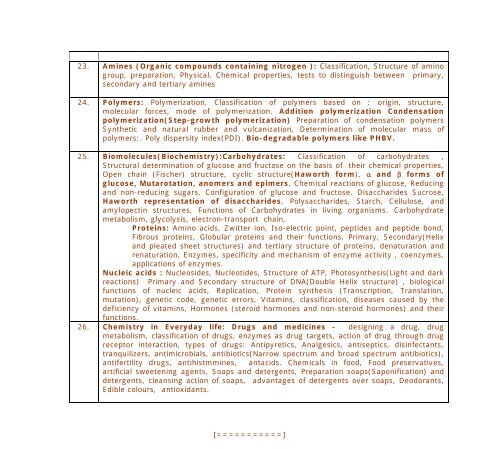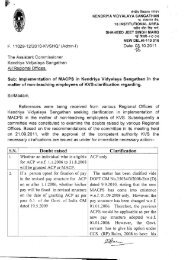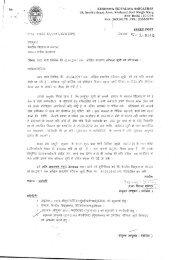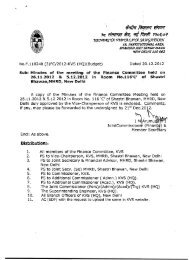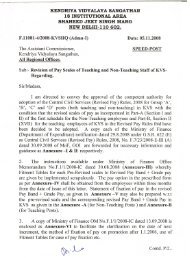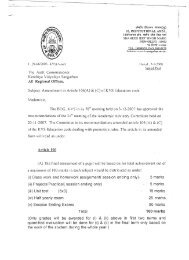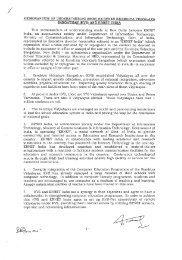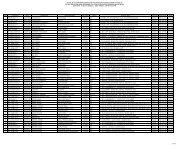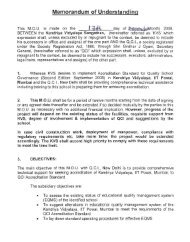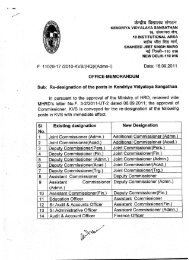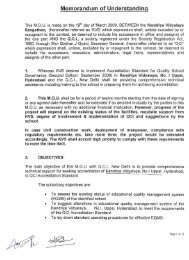Trends in variation of the properties, reaction of alkali and alkaline earth metals.Preparation and properties and uses of some important compounds: - sodium carbonate,sodium bicarbonate, sodium chloride, sodium hydroxide, calcium hydroxide and calciumcarbonate, industrial uses of lime and lime stone, biological importance of sodium,potassium, magnesium and calcium.14. p – Block Elements: Electronic configuration, variation in physical and chemical propertiesof groups 13 to 18, physical and chemical properties of borax, boric acid, boron hydride,silicones, preparation and uses, preparation, properties and uses of nitrogen, ammonia,nitric acid and oxides of nitrogen, phosphorus – allotropic <strong>for</strong>ms, preparation and propertiesof phosphine,phosphorus pentachloride and phosphorus trichloride, preparation, properties and uses ofoxygen and ozone, hydrides and halides of 16 group elements, their structure and nature,allotropic <strong>for</strong>ms of sulphur- their preparation, preparation, properties and uses of sulphurdioxide, industrial preparation of oxo-acids of sulphur, preparation and properties ofhalogen and halogen acids, inter halogen compounds, pseudohalide ions. Oxo-acids ofhalogens, their structure and nature, preparation, properties and uses of xenon fluorides,oxides of xenon and xenon oxo fluorides.15. The d – and f- Block Elements: General introduction, electronic configuration andgeneral trend in the properties of first row transition metals like metallic character,ionization enthalpy, oxidation states, ionic radii, coloured ion <strong>for</strong>mation, catalyticproperties, magnetic properties, oxides, halides and sulphides of first row transition metals,complex compound <strong>for</strong>mation etc. Preparation, properties and structures of KMnO 4 andK 2 Cr 2 O 7 , lanthanoids and actinoids.16. Co-ordination Compounds and organometallics: Meaning of co-ordination compounds,Werner’s theory, ligands – their types, IUPAC nomenclature of co- ordination compounds,isomerism, bonding in co-ordination compounds, colour, magnetic properties and,stabilities of co-ordination compounds. Chemical and biological importance of coordinationcompounds, metal carbonyls: preparation, properties and bonding,organometallic compounds and their classification.17. Organic Chemistry : Some Basic Principles and Techniques: General Classification o<strong>for</strong>ganic compounds, Shapes of organic compounds-Hybridisation(sp, sp 2 ,sp 3 ), Structuralrepresentation of organic molecules, Functional groups, Homologous, series. Common ortrivial names, nomenclature of aliphatic, aromatic and substituted aromatic compounds.Isomerism : Structural and Stereo isomerism Fundamental Concepts inReaction Mechanism: Cleavage of covalent bond, Types of attacking species,electron movement in organic reactions, electronic displacement in a covalentbond and types of organic reactions.Methods of purification of organic compounds: Qualitative analysis,Quantitative analysis., estimation of the elements and determination of empirical andmolecular <strong>for</strong>mula.18. Hydrocarbons: Classification of hydrocarbons.Alkanes: Con<strong>for</strong>mations (Newmann and Sawhorse <strong>for</strong>mulae), Physical properties,Chemical reactionsCycloalkanes: Preparation, physical and chemical properties, stability ofcycloalkanes(Bayer strain theory), chair and boat <strong>for</strong>ms of cyclohexane.Alkenes:, structure of double bond, geometrical isomerism, physical properties,methods of preparation, chemical reactions.Alkadienes: Classification of dienes, Preparation of conjugated dienes, Chemicalproperties(1,2 and 1,4- addition to conjugated dienes).Alkynes:, structure of triple bond, physical properties, methods of preparationChemical properties, Acidic nature of alkynesAromatic Hydrocarbons:, Structure of benzene, resonance, aromaticity (Huckel’s rule)Chemical properties, mechanism of electrophilic substitution direct influence of substituentsin monosubustituted benzene.19. Environmental Chemistry: Environmental pollution, Atmospheric pollution, Troposphericpollution(Air pollution), Major air pollutants, Control of air pollution, Smog(Chemical andPhotochemical smog), Stratospheric pollution: Ozone layer and its depletion, Acid rain,Green House Effect and Global warming, Water pollution, Soil pollution and Industrialwaste.20. Haloalkanes and Haloarenes: Classification, methods of preparation of haloalkanes andhaloarenes, their physical properties, tests to distinguish between alkyl and aryl halides,mechanism of SN 1 and SN 2 reactions, elimination reactions (Saytzeff Rule, E 1 & E 2mechanism).Poly halogen compounds: Preparation and properties.21. Alcohols, Phenols and Ethers: Classification, preparation, properties and uses, tests todistinguish between primary, secondary and tertiary alcohols. Distinctions between alcoholsand phenols. Preparation of ethers , physical and chemical properties.22. Aldehydes, Ketones and Carboxylic Acids: Structure of carbonyl group, preparation ofaldehydes and ketones, physical , Chemical properties and uses, tests to distinguishbetween aldehydes and ketones .Preparations of carboxylic acids preparation propertiesand uses.
23. Amines (Organic compounds containing nitrogen ): Classification, Structure of aminogroup, preparation, Physical, Chemical properties, tests to distinguish between primary,secondary and tertiary amines24. Polymers: Polymerization, Classification of polymers based on : origin, structure,molecular <strong>for</strong>ces, mode of polymerization. Addition polymerization Condensationpolymerization(Step-growth polymerization) Preparation of condensation polymersSynthetic and natural rubber and vulcanization, Determination of molecular mass ofpolymers:. Poly dispersity index(PDI). Bio-degradable polymers like PHBV.25. Biomolecules(Biochemistry):Carbohydrates: Classification of carbohydrates ,Structural determination of glucose and fructose on the basis of their chemical properties,Open chain (Fischer) structure, cyclic structure(Haworth <strong>for</strong>m), and <strong>for</strong>ms ofglucose, Mutarotation, anomers and epimers, Chemical reactions of glucose, Reducingand non-reducing sugars, Configuration of glucose and fructose. Disaccharides Sucrose,Haworth representation of disaccharides, Polysaccharides, Starch, Cellulose, andamylopectin structures, Functions of Carbohydrates in living organisms. Carbohydratemetabolism, glycolysis, electron-transport chain,Proteins: Amino acids, Zwitter ion, Iso-electric point, peptides and peptide bond,Fibrous proteins, Globular proteins and their functions, Primary, Secondary(Helixand pleated sheet structures) and tertiary structure of proteins, denaturation andrenaturation, Enzymes, specificity and mechanism of enzyme activity , coenzymes,applications of enzymes.Nucleic acids : Nucleosides, Nucleotides, Structure of ATP, Photosynthesis(Light and darkreactions) Primary and Secondary structure of DNA(Double Helix structure) , biologicalfunctions of nucleic acids, Replication, Protein synthesis (Transcription, Translation,mutation), genetic code, genetic errors, Vitamins, classification, diseases caused by thedeficiency of vitamins, Hormones (steroid hormones and non-steroid hormones) and theirfunctions.26. Chemistry in Everyday life: Drugs and medicines - designing a drug, drugmetabolism, classification of drugs, enzymes as drug targets, action of drug through drugreceptor interaction, types of drugs: Antipyretics, Analgesics, antiseptics, disinfectants,tranquilizers, antimicrobials, antibiotics(Narrow spectrum and broad spectrum antibiotics),antifertility drugs, antihistmmines, antacids. Chemicals in food, Food preservatives,artificial sweetening agents, Soaps and detergents, Preparation soaps(Saponification) anddetergents, cleansing action of soaps, advantages of detergents over soaps, Deodorants,Edible colours, antioxidants.[===========]


